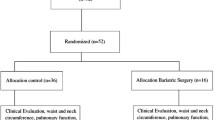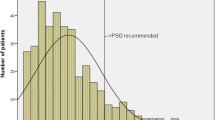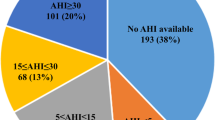Abstract
Background
Obesity has become one of the greatest public health concerns worldwide and is known to be the most important risk factor for obstructive sleep apnoea (OSA). Prevalence of OSA has increased over the last two decades, but it is estimated that the majority of cases still remain undiagnosed. The aim of this study was to investigate the prevalence of OSA in Finnish bariatric surgery candidates.
Methods
In this prospective multicentre study, standard overnight cardiorespiratory recording was conducted in 197 consecutive patients from three different hospitals. A sleep questionnaire was also administered. Anthropometric and demographic measurements included age, weight, body mass index (BMI) and waist and neck circumference.
Results
Altogether, 71 % of the patients were diagnosed with OSA. The prevalence was higher in males (90 %) than in females (60 %) (p < 0.001). In OSA patients’ group, the mean neck and waist circumference was larger (p < 0.001) and the body weight higher (p < 0.01) than in non-OSA group. When separating patients by gender, a significant difference remained only concerning neck circumference in female patients.
Conclusions
OSA is very common among bariatric surgery patients, especially in men. Considering this and the increased long-term morbidity and mortality generally related to OSA, a routine screening for OSA seems indicated in bariatric patients, particularly men.
Similar content being viewed by others
References
World Health Organization. Obesity and Overweight Fact Sheet N8311. 2006. Available from: http://www.who.int/mediacentre/factsheets/fs311/en
World Health Organization. Global surveillance, prevention and control of chronic respiratory diseases: a comprehensive approach. 2007. Available from: http://www.who.int/gard/publications/GARD_Manual/en/
Tuomilehto H, Peltonen M, Partinen M, et al. Sleep-disordered breathing is related to an increased risk for type 2 diabetes in middle-aged men, but not in women—the FIN D2D-survey. Diabetes Obes Metab. 2008;10(6):468–75.
Tasali E, Mokhlesi B, Van Cauter E. Obstructive sleep apnea and type 2 diabetes: interacting epidemics. Chest. 2008;133:496–506.
Punjabi N, Caffo B, Goodwin J, et al. Sleep-disordered breathing and mortality: a prospective cohort study. PLoS Med. 2009;6:e1000132.
Muraja-Murro A, Eskola K, Kolari T, et al. Mortality in middle-aged men with obstructive sleep apnea in Finland. Sleep Breath. 2013;17(3):1047–53.
Pack A, Gislason T. Obstructive sleep apnea and cardiovascular disease: a perspective and future directions. Prog Cardiovasc Dis. 2009;51(5):434–51. Review.
Tuomilehto H, Seppä J, Uusitupa M. Obesity and obstructive sleep apnea—clinical significance of weight loss. Sleep Med Rev. 2013;17:321–9.
Ashrafian H, le Roux C, Rowland S, et al. Metabolic surgery and obstructive sleep apnoea: the protective effects of bariatric procedures. Thorax. 2012;67:442–9.
Peiser J, Lavie P, Ovnat A, et al. Sleep apnea syndrome in the morbidly obese as an indication for weight reduction surgery. Ann Surg. 1984;199:112–5.
Charuzi I, Lavie P, Peiser J, et al. Bariatric surgery in morbidly obese sleep-apnea patients: short- and long-term follow-up. Am J Clin Nutr. 1992;55:594S–6.
Haines K, Nelson L, Gonzales R, et al. Objective evidence that bariatric surgery improves obesity-related obstructive sleep apnea. Surgery. 2007;141:354–8.
Lettieri C, Eliasson A, Greenburg D. Persistence of obstructive sleep apnea after surgical weight loss. J Clin Sleep Med. 2008;4:333–8.
American Academy of Sleep Medicine Task Force. Sleep-related breathing disorders in adults: recommendations for syndrome definition and measurement techniques in clinical research. Sleep. 1999;22:667–89.
Carneiro G, Flório R, Zanella M, et al. Is mandatory screening for obstructive sleep apnea with polysomnography in all severely obese patients indicated? Sleep Breath. 2012;16:163–8.
Sareli A, Cantor C, Williams N, et al. Obstructive sleep apnea in patients undergoing bariatric surgery—a tertiary center experience. Obes Surg. 2011;21:316–27.
Aguiar I, Freitas Jr W, Santos I, et al. Obstructive sleep apnea and pulmonary function in patients with severe obesity before and after bariatric surgery: a randomized clinical trial. Multidiscip Respir Med. 2014;9:43.
Sharkey K, Machan J, Tosi C, et al. Predicting obstructive sleep apnea among women candidates for bariatric surgery. J Women’s Health (Larchmt). 2010;19:1833–41.
Kolotkin R, LaMonte M, Walker J, et al. Predicting sleep apnea in bariatric surgery patients. Surg Obes Relat Dis. 2011;7:605–10.
Valencia-Flores M, Orea A, Herrera M, et al. Effect of bariatric surgery on obstructive sleep apnea and hypopnea syndrome, electrocardiogram, and pulmonary arterial pressure. Obes Surg. 2004;14:755–62.
Lee Y, Johan A, Wong K, et al. Prevalence and risk factors for obstructive sleep apnea in a multiethnic population of patients presenting for bariatric surgery in Singapore. Sleep Med. 2009;10:226–32.
Koeck E, Barefoot L, Hamrick M, et al. Predicting sleep apnea in morbidly obese adolescents undergoing bariatric surgery. Surg Endosc. 2014;28:1146–52.
Dixon J, Schachter L, O’Brien P. Predicting sleep apnea and excessive day sleepiness in the severely obese: indicators for polysomnography. Chest. 2003;123:1134–41.
Chung F, Yang Y, Liao P. Predictive performance of the STOP-Bang score for identifying obstructive sleep apnea in obese patients. Obes Surg. 2013;23(12):2050–7.
Toshniwal G, McKelvey GM, Wang H. STOP-Bang and prediction of difficult airway in obese patients. J Clin Anesth. 2014;26(5):360–7.
Proczko M, Stepaniak P, de Quelerij M, et al. STOP-Bang and the effect on patient outcome and length of hospital stay when patients are not using continuous positive airway pressure. J Anesth. 2014;28(6):891–7.
Nepomnayshy D, Hesham W, Erickson B, et al. Sleep apnea: is routine preoperative screening necessary? Obes Surg. 2013;23:287–91.
Weingarten T, Flores A, McKenzie J, et al. Obstructive sleep apnoea and perioperative complications in bariatric patients. Br J Anaesth. 2011;106(1):131–9.
Meoli A, Rosen C, Kristo D, et al. Upper airway management of the adult patient with obstructive sleep apnea in the perioperative period—avoiding complications. Sleep. 2003;26:1060–5.
Hwang D, Shakir N, Limann B, et al. Association of sleep-disordered breathing with postoperative complications. Chest. 2008;133:1128–34.
Aminian A, Brethauser S, Kirwan J, et al. How safe is metabolic/diabetes surgery? Diabetes Obes Metab. 2015;17(2):198–201.
Buchwald H, Estok R, Fahrbach K, et al. Trends in mortality in bariatric surgery: a systematic review and meta-analysis. Surgery. 2007;142(4):621–32.
Collop N, Anderson W, Boehlecke B, et al. Clinical guidelines for the use of unattended portable monitors in the diagnosis of obstructive sleep apnea in adult patients. J Clin Sleep Med. 2007;3:737–47.
Acknowledgments
The authors cordially acknowledge Miia Artama, PhD, for her critical assistance with statistical analysis; Jaana Elberkennou, MD, MA, for her kind revision of the English language and the clinical research nurses Synnöve Liukku, Helinä Mäkipää, Taina Poutiainen, Matti Laitinen and Marjo Soini.
Author information
Authors and Affiliations
Corresponding author
Ethics declarations
Conflict of Interest
The authors declare that they have no competing interests.
Ethical Approval
All procedures performed in this study were in accordance with the ethical standards of the national research committee and with the 1964 Helsinki Declaration and its later amendments or comparable ethical standards.
Informed Consent
Informed consent was obtained from all individual participants included in the study.
Rights and permissions
About this article
Cite this article
Peromaa-Haavisto, P., Tuomilehto, H., Kössi, J. et al. Prevalence of Obstructive Sleep Apnoea Among Patients Admitted for Bariatric Surgery. A Prospective Multicentre Trial. OBES SURG 26, 1384–1390 (2016). https://doi.org/10.1007/s11695-015-1953-7
Published:
Issue Date:
DOI: https://doi.org/10.1007/s11695-015-1953-7




